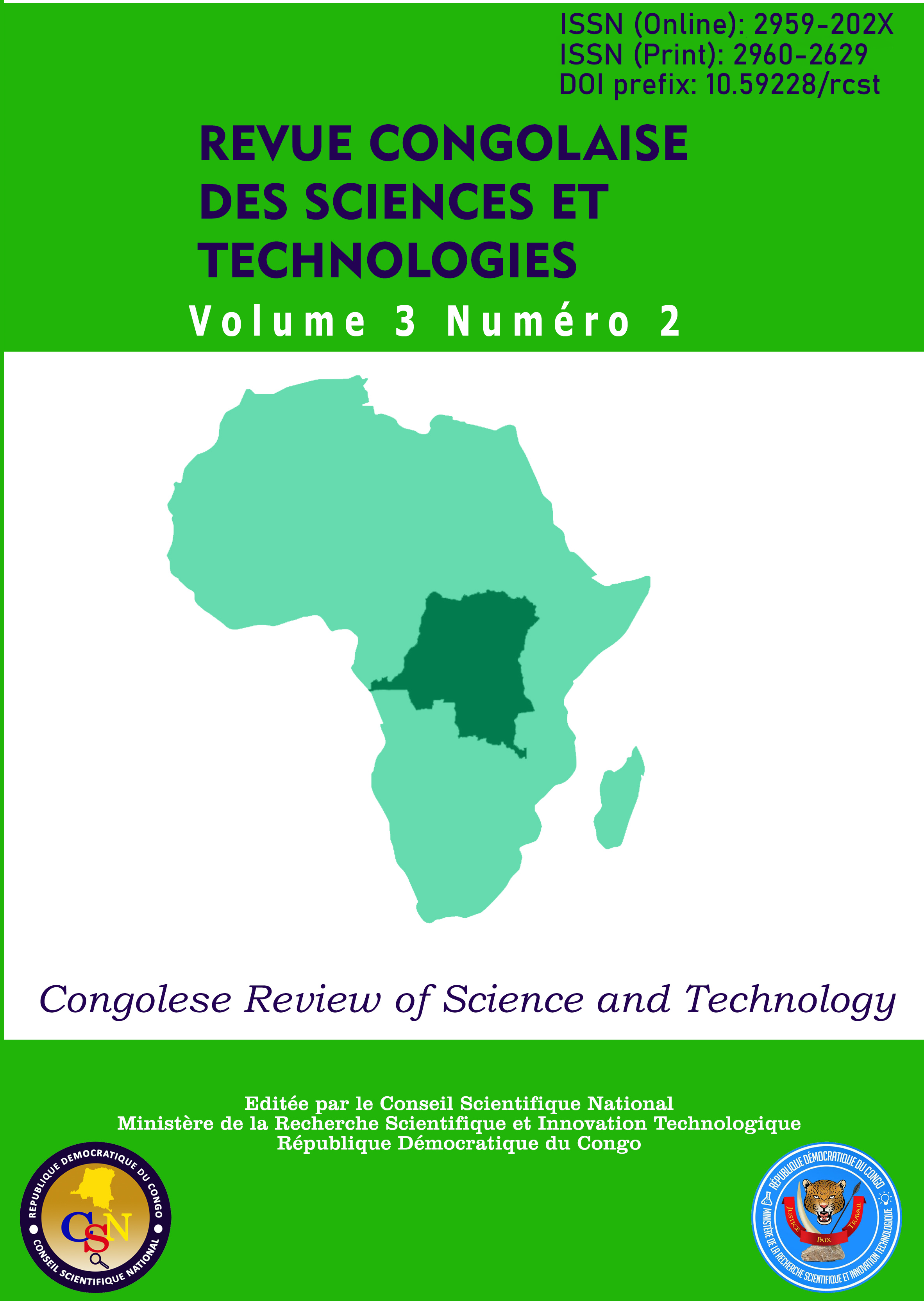Évaluation de l'activité antibactérienne de Mitragyna stipulosa (DC.) O. (Kuntze, 1891) sur Streptococcus pneumoniae (Klein, 1884) Chester, agent causal des Pneumonies
Main Article Content
Abstract
Pneumonia is one of the leading causes of death in children under five and, a major cause of infant mortality in all regions of
the world, most deaths occur in sub-Saharan Africa and South Asia. The main agent with the highest prevalence in severe
pneumonia is, as the name suggests the bacterium Streptococcus pneumoniae. The general objective of this study is to evaluate
the antibacterial activity of the decoction of the leaves of Mitragyna stipulosa on the bacterium S. pneumoniae by the
antibiogram test, to determine the minimum inhibitory concentration and, to compare the antibacterial effect of the decoction
compared to infusion and maceration, as well as the reference antibiotic used. This work is part of the promotion and
enhancement of the African pharmacopoeia in general and the Congolese pharmacopoeia in particular, to overcome a proven
and significant public health problem.
Article Details

This work is licensed under a Creative Commons Attribution-NonCommercial-ShareAlike 4.0 International License.
References
Aboaba, O. O., Smith, S. I., & Olude, F. O. (2006).
Antibacterial effect of edible plant extract on
Escherichia coli 0157. Pakistan Journal of
Nutrition, 5(4), 325- 327.
Adjanohoum, J. E., Aké, A. L., Floret, J. J., Guinko,
S., Koumaré, M., Ahyi. A. M., & Raynal. J.
(2001). Médicine traditionnelle et Pharmacopée
Contribution aux études ethnobotaniques et
florestiques au Mali. Paris, ACCT.
Akula, R., & Ravishankar, G. A. (2011). Influence of
abiotic stress signals on secondary metabolites
in plants. Plant Signaling & Behavior, 6(11),
–1731. doi:10.4161/psb.6.11.17613.
Bogaert, D., de Groot, R., & Hermans, P. W. (2004).
Streptococcus pneumoniae colonisation: the key
to pneumococcal disease. Lancet Infect. Dis., 4
(3), 144–154. doi: 10.1016/S1473-
(04)00938-7
Burckhardt, I., Panitz, J., Burckhardt, F., &
Zimmermann, S. (2017). Identification of
Streptococcus pneumoniae: Development of a
Standardized Protocol for Optochin
Susceptibility Testing Using Total Lab
Automation. BioMed Research International, 1–
doi:10.1155/2017/4174168
Celikel, N., & Kavas, G. (2008). Antimicrobial
properties of some essential oils against some
pathogenic microorganisms. Czech Journal of
Food Sciences, 26 (3), 174.
Cohen, R., Levy, C., Bingen, E., Bechet, S., Derkx, V.,
Werner, A., & et al. (2012). Portage
rhinopharyngé d’enfants âgés de six à 60 mois
durant l’implémentation du vaccin
pneumococcique conjugué 13- valent. Arch
Pédiatrie, 19(10), 1132 9.
Dalmarco, J., Dalmarco, E., Koelzer, J., Pizzolatti, M.,
& Fröde, T. (2010). Isolation and identification
of bioactive compounds responsible for the antibacterial efficacy of Lotus corniculatus var. São
Gabriel. Int. J. Green Pharm., (4), 108-114.
Fageyinbo, M. S., Odumeso, A. O., Rotimi, K. I.,
Fasipe, O. J., & Olayemi, S. O. (2018).
Anticonvulsant, anxiolytic and sedative
activities of hydro-ethanolic leaf extract of
Mitragyna stipulosa. Journal of Herbs, Spices &
Medicinal Plants. 25(1), 43–54.
doi:10.1080/10496475.2018.1556373
Fatima, N., Tapondjou, L., Lontsi, D., Sondengam, B.,
Atta-Ur-Rahman, U., & Choudhary, M. (2002).
Quinovic Acid Glycosides From Mitragyna
Stipulosa - First Examples of Natural Inhibitors
of Snake Venom Phosphodiesterase I. NaturalProduct Letters. 16(6), 389–393.
doi:10.1080/10575630290033169
Freney, J. (2007). Précis de bactériologie clinique.
Paris, Éd. Eska
Gong, F., Hai-peng, G., & Qi-tai Xu, W. (2012).
Genus Mitragyna : Ethnomedicinal uses and
pharmacological studies. Phytopharmacology,
(2), 263-272.
Govindappa, M., Bharath, N., Shruthi, H., Sadananda,
T., & Sharanappa, P. (2011). Antimicrobial,
antioxidant and in vitro antiinflammatory
activity and phytochemical screening of
Crotalaria pallida Aiton. Afr. J. Pharm.
Pharmacol., 5(21), 2359-2371.
Janoir, C. (2014). Infections à pneumocoques. EMC -
Mal Infect., 11(3), 1 17.
Jehl, F., Chabaud, A., & Grillon, A. (2015).
L’antibiogramme : diamètres ou CMI ? Journal
Des Anti-Infectieux, 17(4), 125–139.
doi:10.1016/j.antinf.2015.08.003
Karbwang, J., Crawley, F. P., Na-Bangchang, K., &
Maramba-Lazarte, C. (2019). Herbal Medicine
Development: Methodologies, Challenges, and
Issues. Evidence-Based Complementary and
Alternative Medicine. (9), 1–2.
doi:10.1155/2019/4935786
Kumazawa, J., & Yagisawa, M. (2002). The history of
antibiotics: The Japanese story. Journal of
Infection and Chemotherapy, 8(2), 125–133.
doi:10.1007/s101560200022
Linthoingambi, W., & Mutum, S. (2013).
Antimicrobial activities of different solvent
extracts of Tithonia diversifolia (Hemsely) A.
Gray. Asian J. Plant Sci. Res., 3(5), 50-54.
Marimuthu, M., Aruldass, C., Sandrasagaran, U.,
Mohamad, S., Ramanathan, S., Mansor, S., &
Murugaiyah, V. (2014). Antimicrobial activity
and phytochemical screening of various parts of
Ixora coccinea. J. Med. Plants Res. 8(10), 423-
Orihuela, C. J, & Tuomanen, E. I. (2006). Models of
pneumococcal disease. Drug Discov Today Dis
Models., 3(1), 69 75.
Ponce, A., Fritz, R., Del Valle, C., & Roura, S. (2003).
Antimicrobial activity of essential oils on the
native microflora of organic Swiss chard.
Lebensm. Wiss. Technol. (36); 679-684.
Rossi, F., Franco, M., Rodrigues, H., & Andreazzi, D.
(2012). Streptococcus pneumoniae:
sensibilidade a penicilina e moxifloxacina.
Jornal Brasileiro de Pneumologia. 38(1), 66–
doi:10.1590/s1806-37132012000100010
Sandeep, K., Shrivastava, B., Khajuria, R. (2010).
Antimicrobial activity of Crotalaria burhia
Buch.-Ham. Indian J. Nat. Prod. Resour., 1(4),
-484.
Saxena, M., Saxena, J., Nema, R., Singh, D., & Gupta,
A. (2013). Phytochemistry of medicinal plants.Journal of pharmacognosy and phytochemistry,
(6).
Shaki, U., & Soulaymani, B. (2008).
Pharmacovigilance des plantes médicinales.
Rabbat, Centre de Pharmacovigilence du Maroc.
Simell, B., Auranen, K., Käyhty, H., Goldblatt, D.,
Dagan, R., & O’Brien, K. (2012). The
fundamental link between pneumococcal
carriage and disease. Expert Rev. Vaccines, 11
(7), 841–855. doi: 10.1586/erv.12.53
Soussy, C., Bonnet, C., Cavallo, C., Chidiac, C.,
Dubreuil, J., Jehl, L., Leclerc, Lina., Merens, N.,
Plesiat, P., Quentin, V. (2013). Comité de
l’antibiogramme de la société française de
microbiologie, recommandations. Paris, Centre
hospitalier universitaire Henri Mondor.
Wardlaw, T., Emily, W., & Matthew, H. (2006). La
pneumonie de l’enfant : un fléau oublié.
UNICEF/OMS. Paris, Paris.
WHO. (2002). Médecine traditionnelle. (Consulted on
december 2011).
http:www.who.int/mediacentre/factsheets/
/fs134/fr/

